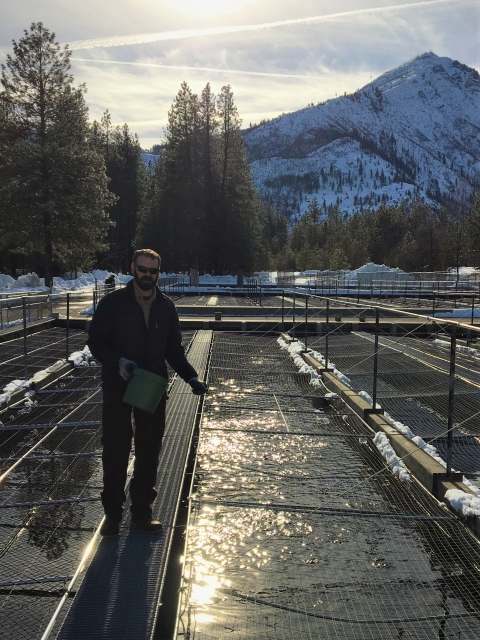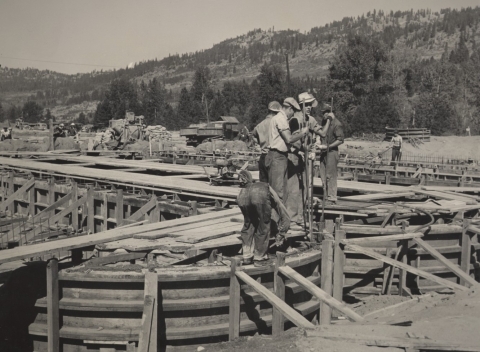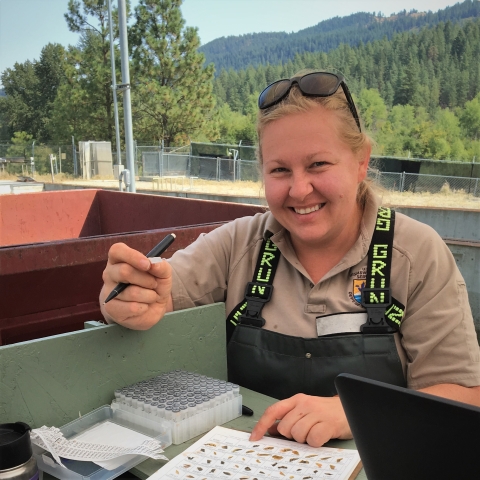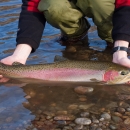About Us
Since 1871 the National Fish Hatchery system has been at work improving recreational fishing and restoring aquatic species that are in decline, at risk, and are important to the health of our aquatic systems. Across the country, the network of national fish hatcheries work with states and tribes to conserve, restore and enhance the fish and aquatic resources of America for future generations.
Leavenworth National Fish Hatchery is the headquarters for the Leavenworth Fisheries Complex. Our offices are in the two story main building, which is on the National Register of Historic Places. When the hatchery was built, it was the largest fish hatchery in the world! Since 1940, our work has evolved to better meet our responsibilities. Currently, we raise 1.2 million spring Chinook salmon each year, with an additional 1 million coho salmon raised through our partnership with the Yakama Nation Fisheries. The hatchery is also home to the Mid-Columbia Fish and Wildlife Conservation Office, a public boat launch, a tribal fishing area, and 5 miles of public trails. Leavenworth NFH Video Series
Our Mission
Since 1871, national fish hatcheries have been applying science-based approaches to conservation challenges. We work with our partners and engage the public to conserve, restore, and enhance fish and other aquatic resources for the continuing benefit of the American people. Conservation is at the heart of what we do, and we recognize that we do this work for the American people–both the present generation who benefit today and future generations who will inherit our legacy of conserving America’s aquatic resources.
We are a mitigation hatchery established by the Grand Coulee Fish Maintenance Project (1937) to compensate for anadromous fish losses above Grand Coulee Dam. The mission of our program is to provide harvest opportunities while minimizing impacts to natural populations and the habitats they occupy. The hatchery produces spring Chinook salmon. We also raise coho salmon in cooperation with the Yakama Nation. The Columbia River Fisheries Management Plan under the U.S. v. Oregon decision of 1969 set production goals for the fisheries.
Our History
Construction of the hatchery took place from 1938 to 1940 on 170 acres of Icicle Valley land, two miles south of the town of Leavenworth.
When the hatchery was first established, spring Chinook salmon and steelhead were identified as the primary mitigation species. The initial operating plan called for adult spring Chinook salmon and summer steelhead to be trapped at Rock Island Dam and hauled to the hatchery for holding and spawning. Salmon and steelhead trapped at the Rock Island Dam represented a mix of fish destined for the upper Columbia River system. Leavenworth was originally considered to be the primary adult holding and spawning site, with eggs shipped from there to the Entiat and Winthrop hatcheries.
Over the years, our production program has included a variety of species, including spring and summer Chinook salmon, coho salmon, steelhead, kokanee, and various resident salmonids. Since 1974, spring Chinook salmon have been the priority species. The continued success of the program provides for sport, tribal, and commercial fisheries in the Pacific Ocean, Columbia River, and Icicle Creek. Released smolts and returning adults must travel 497 river miles between the hatchery and the Pacific Ocean.
In 1998, the hatchery was placed on the National Register of Historic Places by the U.S. Department of the Interior, recognizing the historic significance of its construction in 1939. Major features on the facility site now include the hatchery building nursery and visitor center, adult holding ponds, fish ladder, numerous raceways, historic Foster-Lucas rearing ponds, sand settling basin, pollution abatement pond, and nature trail.
Other Facilities in this Complex
Entiat, Leavenworth, and Winthrop national fish hatcheries are mitigation hatcheries established by the Grand Coulee Fish Maintenance Project (1937) to compensate for anadromous fish losses above Grand Coulee Dam. All three produce spring or summer Chinook salmon, and Winthrop NFH produces steelhead.
As part of the Leavenworth Fisheries Complex, the Mid-Columbia Fish and Wildlife Conservation Office evaluates the hatchery production programs, provides technical assistance, and assists the coordination of operations and production. The MCFWCO cooperates with other Service programs, agencies, tribes, and entities using and managing aquatic species and their habitats in the mid- and upper-Columbia River Basin.







